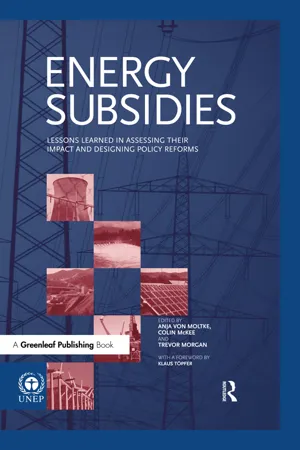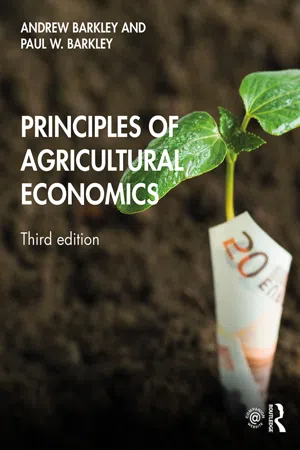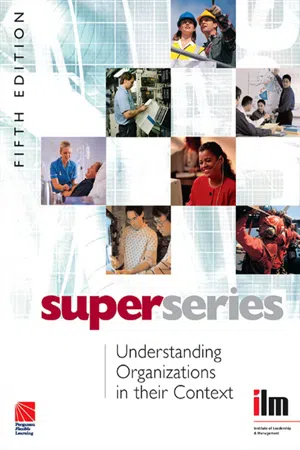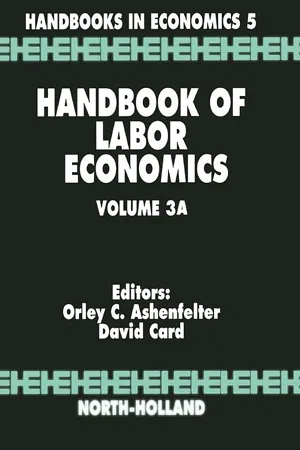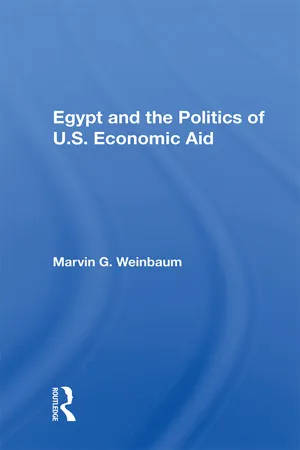Economics
Effects of Subsidies
Subsidies can have various effects on the economy. They can lead to lower prices for consumers, stimulate production and consumption, and support the growth of specific industries. However, subsidies can also create market distortions, encourage inefficiency, and lead to budgetary pressures for the government.
Written by Perlego with AI-assistance
Related key terms
7 Key excerpts on "Effects of Subsidies"
- eBook - ePub
Energy Subsidies
Lessons Learned in Assessing their Impact and Designing Policy Reforms
- Anja von Moltke, Colin McKee, Trevor Morgan, Klaus Töpfer(Authors)
- 2017(Publication Date)
- Routledge(Publisher)
Chapter 11 demonstrate that the short-run economic costs can be significant. How subsidy reform affects different economic sectors and the distribution of income among households depends on how energy subsidies are financed and how the proceeds used when they are eliminated. These costs have to be traded off against the environmental benefits and the long-run economic and social benefits of subsidy removal.12.4 Environmental effectsThe changes in economic resource allocation brought about by the introduction, removal or change in an energy subsidy always have implications for the environment and social welfare. Indeed, the reason many subsidies exist at all is to support a particular social or environmental goal. For all the theoretical arguments in support of targeted intervention, governments are questioning more and more the validity of certain types of energy subsidy. This is mainly because of a shift in policy priorities as concerns about both the environmental consequences of encouraging energy use and the economic cost of subsidy programmes grow. A prime example is the Kyoto Protocol, which requires a reduction of subsidies that encourage greenhouse gas emissions.46The preceding chapters illustrate the complexity of the environmental effects of energy subsidies. They can be both positive and negative, depending on the precise nature of the subsidy and the energy source that it supports. Subsidies that encourage the production and use of fossil fuels inevitably have some harmful consequences for the environment. Consumer subsidies that lower the price paid for those fuels or the cost of using them result in increased consumption. This can lead to higher airborne emissions of noxious and greenhouse gases as well as other forms of environmental damage such as water contamination and spoiling of the landscape. The use of fossil fuels is particularly damaging to the environment. - eBook - ePub
Global Trade Policy
Questions and Answers
- Pamela J. Smith(Author)
- 2013(Publication Date)
- Wiley-Blackwell(Publisher)
What are export subsidies, their types and purposes? An export subsidy is a payment made by the government to firms that export a specific good. The purpose of export subsidies is to provide an incentive for producers to export into foreign markets. That is, export subsidies serve to protect the domestic industry against competition with lower priced goods in the international market. Export subsidies take a variety of forms, including cash payments. Export subsidies are typically levied on an ad valorem or specific basis.What are the effects of export subsidies? The effects of export subsidies depend on the conditions in the exporting and importing countries. We considered four cases in this chapter.First, what are the effects of an export subsidy imposed by a large exporter? When the exporting country is large, a subsidy affects the price in the exporter and the world price of the good. Specifically, a subsidy increases the price of the good in the exporter and decreases the price of the good in the importer. As a result, agents in both the exporter and importer are affected. In the exporter, producers supply more for the international market and receive a higher subsidy-inclusive price. The export subsidy puts upward pressure on the price of the domestically consumed good such that producers are indifferent between supplying the domestic and international markets. Producers gain in terms of revenue from domestic and international sales. At the same time, consumers demand less at the higher domestic price. They lose in terms of the higher cost of the good. Consumers continue to consume only domestically produced goods, but fewer of them.Alternatively, in the importer, producers supply less to their domestic market at the lower world price, as they must compete with the lower price imports of subsidized goods. These domestic producers in the importer lose in terms of revenue from domestic sales. And consumers in the importer demand more at the lower world price. They gain in terms of the lower cost of the good. Consumers consume more imported goods and fewer domestic goods.The subsidy also results in welfare changes in both the exporting and importing countries. In the exporter, producer welfare increases, consumer welfare decreases, and government welfare decreases from the cost of the subsidy. The net country welfare effect includes a negative terms of trade effect and negative production and consumption distortions. The exporting country is unambiguously worse off as a result of the subsidy. Alternatively, in the importer, the producer's welfare decreases, consumer's welfare increases, and government welfare does not change. The net country welfare effect includes a positive terms of trade effect and negative production and consumption distortions. The importing country is better off as a result of the subsidy because the positive terms of trade improvement exceeds the distortions. - eBook - ePub
- Andrew Barkley, Paul W. Barkley(Authors)
- 2020(Publication Date)
- Routledge(Publisher)
Markets are enormously useful and adaptable institutions. Government intervention into markets typically has unanticipated consequences which distort the market mechanism. In the case of the price support, put in place to assist producers, the taxpayers and consumers must pay a large sum of money to the recipients of the price support. A price ceiling results in a shortage of the good and some unsatisfied consumers. Government intervention takes away the “self-correcting” nature of markets, which will always result in the attainment of equilibrium, or a situation where the quantity supplied is equal to the quantity demanded.11.2 Welfare economics
The term “welfare economics ” refers to the study of how well off individual and groups are. Of particular interest is how the welfare, or well-being, of individuals or groups such as producers and consumers change due to a change in policy, market, or current event.- • Welfare Economics = a branch of economics that seeks to measure and understand how the well-being (welfare) of individuals changes in response to changes in policies, markets, or current events.
Note that the word “welfare” in this case does not refer to social programs or public aid intended to provide financial assistance to needy individuals. When used in economics, welfare simply refers to “well-being,” or how well off a group is, measured in dollars.Most importantly, welfare economics provides a method for measuring how well off different groups are in an economy by placing a dollar value on each group’s welfare. In this way, welfare economic is used to quantify and evaluate proposed and actual changes in policies and markets: a simple way to describe welfare economics is “who is helped, who is hurt, and by how much.” - eBook - ePub
Handbook of International Food and Agricultural Policies
(In 3 Volumes)Volume 1: Policies for Agricultural Markets and Rural Economic ActivityVolume 2: Policies for Food Safety and Quality, Improved Nutrition, and Food SecurityVolume 3: International Trade Rules for Food and Agricultural Products
- William H Meyers, Thomas Johnson, Donna H Roberts, Karl Meilke(Authors)
- 2017(Publication Date)
- WSPC(Publisher)
The WTO Agreement on Agriculture, Article 12.2, introduces disciplines for export prohibitions and restrictions for agricultural goods, but again no mention is made of export taxes. However, a number of regional trade agreements have prohibited export taxes including: the EU, NAFTA, CARICOM, MERCOSUR, ANZCERTA, Canada–Chile, Canada–Costa Rica, Japan–Singapore, and EU–Mexico (Piermartini, 2004).Direct Export Subsidies4A direct export subsidy provides an explicit price discount that effectively lowers an importer’s traded price for the product or service in question. These discounts not only include bonuses paid by government agencies to increase exports but also transportation, handling, and inspection services that are provided on more favorable terms for exports than for goods sold within the country (Annand et al. , 2001).Regardless of how the program is targeted, a direct export subsidy has the effect of raising producer and consumer prices in the exporter’s home market. This raises production and reduces consumption, redirecting the good from the domestic market to the world market. Again, these effects result in efficiency losses from too little consumption and too much production in the exporter’s market. If the exporter is a small country, the additional exports will have no effect on world prices. As a result, the combined effects of reduced consumer welfare plus government expenditure for the subsidy exceed the increase in producer surplus, so overall welfare decreases for the subsidizing exporter. The overall welfare effects for large country exporters depend on whether the subsidy is targeted at specific countries or is applied generally to all countries.Welfare Effects of Non-Targeted Export SubsidiesThe impacts of non-targeted export subsidies on prices, quantities, and the welfare of individual agents are described in standard trade textbooks (Vousden, 1990). An export subsidy introduced by a large country exporter can depress world prices if the subsidy is large enough. Reduced world prices increase the size of the government expenditures necessary to subsidize the volume of exports. For the same volume of subsidized exports, a large country exporter will incur a larger net welfare loss because larger government expenditures combined with the loss of consumer welfare exceeds the gain to producers by an even larger amount than in the small country case. So unlike an export tax, an export subsidy leads to even larger overall distortions for the exporter with international market power. - eBook - ePub
- Institute of Leadership(Author)
- 2013(Publication Date)
- Routledge(Publisher)
So far in this session we have looked at:how you believe that your prices compare with those of your direct competitors. This may be more or less easy to discover, according to what your organization does, and it may be necessary for you simply to state your impression of the position.any indirect competition you know of. For example, can people change from your product to another, in the same way as they can swap from electricity to gas, from tube trains to buses or from reading papers to listening to radio news?any subsidies involved which affect your organization. Many organizations will not have any, but the football case study shows that subsidies can turn up in unexpected places.the factors of production;their prices;the price mechanism, which normally keeps supply and demand in balance;issues of subsidized pricing and monopolies – public or private – which distort it.These economic concepts are fundamental to understanding all economic issues within your own organization and beyond it. Keeping them in mind will help you understand all the larger issues which will be looked at in the remainder of this session and in Session F.
Governments throughout the world try to control the remorseless interplay of supply and demand with varying degrees of success. Modern governments seem obsessed with economics, but in reality they have far less power than they would like to have.6
The economic levers which governments use
They cannot influence natural phenomena which lead to good or bad harvests or make mines and oil fields unworkable.They frequently do not understand the methods and the technology employed by multinational companies in pursuing their own independent aims. - eBook - ePub
- Orley Ashenfelter, David Card(Authors)
- 1999(Publication Date)
- North Holland(Publisher)
To demonstrate these issues in a dramatic way, consider the effect of a wage subsidy for employment in a labor market for low-skill workers. Assume that firms act to minimize their costs of employment. Wage subsidies operate by taking non-employed persons and subsidizing their employment at firms.As indicated in Table 2 , many active labor market policies have a substantial wage-subsidy component. Suppose that the reason for non-employment of low-skill workers is that minimum wages are set too high. This case is a traditional justification for wage subsidies (see, e.g., Johnson, 1979 ; Johnson and Layard, 1986 ). If the number of subsidized workers is less than the number of workers employed at the minimum wage, a wage subsidy financed from lump sum taxes has no effect on total employment in the low wage sector because the price of labor for the marginal worker hired by firms is the minimum wage which is the same before and after the subsidy program is put in place. The marginal worker is unsubsidized both before and after the subsidy program is put in place.The effects of the program are dramatic on the individuals who participate in it. Persons previously non-employed become employed as firms seek workers who carry a wage subsidy. Many previously-employed workers become non-employed as their employment is not subsidized. There are no effects of the wage subsidy program on GDP unless the taxes raised to finance the program have real effects on output. Yet there is substantial redistribution of employment. Focusing solely on the effects of the program on subsidized workers greatly overstates its impact on the economy at large.In order to estimate the impact of the program on the overall economy,Αin the notation of Section 3φ ˜ - eBook - ePub
- Marvin G. Weinbaum(Author)
- 2019(Publication Date)
- Routledge(Publisher)
The real growth projected at 8.1 percent in Egypt's Five Year Plan (1982/83-1986/87) was predicated on fundamental economic reforms that would, above all, spawn a more competitive export sector and new sources of foreign exchange. Yet prospects seem dim for corrections in budgetary and fiscal policies in general and for major adjustments in the structure of pricing and subsidies in particular. Slowness to reform is not unexpected where so many have benefited from income transfers, and the probable political costs of change are more immediate and incalculable than the anticipated economic benefits. A weak, unreformed economy may eventually, however, undermine Egypt's commitment to minimal consumption levels for its citizens and make aid inflows even more crucial to the country's economic stability. Meanwhile, foreign aid can play a role in helping to promote new policies as well as in sustaining older ones.The Dimensions and Magnitude of Subsidies
Pricing and subsidy policies are critical and sensitive issues in the Egyptian economy.1 Consumer prices for a wide range of basic commodities and services are held down by the government through a system of direct and indirect subsidies and controlled marketing channels. The subsidies for food cover to some degree all the items considered basic to the Egyptian diet, including bread, beans, lentils, refined sugar, rice, tea, cooking oil, red meats, chicken, and fish. Even some foodstuffs not designated as basic, such as margarine and sesame, and such nonfood items as soap and cotton fabric, are sold at artificially low prices. Aside from bread, restrictions apply to consumer access to all subsidized food. Sugar, tea, cooking oil, rice, and other items are rationed and available at their low, fixed prices only at consumer cooperatives and government-owned shops.2
Index pages curate the most relevant extracts from our library of academic textbooks. They’ve been created using an in-house natural language model (NLM), each adding context and meaning to key research topics.
